|
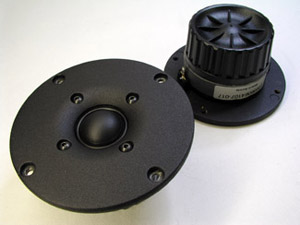
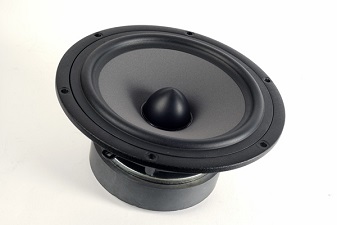
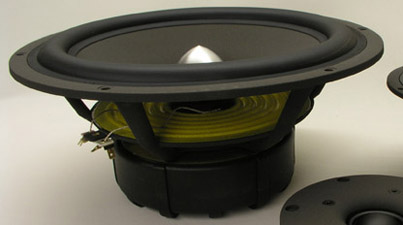
Download
specs here:
T25CF001
T29CF002
W18NX003
W26FX002
25-01-2021:
Jenzen NEXT updated with new W18NX003 driver. No change to crossover.
About once every six
months I pick the Jan Garbarek double-CD Rites (1998) from
the shelf and submerge myself in the sound from this magnificent
recording. I have to be at home - and alone - to fully enjoy the music, as
the presence of any person disturbs the meditation it will take me
into. There are recordings we play over and over again and soon get
bored with, regardless of quality. Not so with Rites. After two
hours of listening I'm full and I
leave it on the shelf for months before I need another fix. By
coincident both drivers and music comes from my favorite holiday
country, Norway.
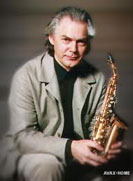
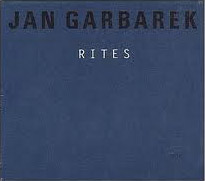
For several years I have played Rites on the DTQWT speakers as
Garbarek's soprano sax is a tough test on quality of mid/tweeter
integration, distortion and overall tonal balance. If you can listen
to these two CDs for some two hours at fairly loud level without
listening fatigue, then your speakers aren't that bad.
Setting up the Jenzen NEXT with the final crossovers, I thought I
might just as well hear if it would pass or fail - and fortunately it passed.
I sat down listening through it all and only had a coffee
break when changing CDs. In fact it was so good I didn't listen to the
speakers for the next two days not to spoil my initial impression. I was afraid
I had just hyped myself up as is often the case when I set up a new
speaker and want it to be good, thinking of all the hours that went
into building it.
The Jenzen NEXT
speaker sensitivity is around 89 dB/2.8V and minimum impedance is 5
ohms. I recommend 80+ watts per channel amplifiers.
What is a Jenzen
speaker?
- the Jenzen speakers are classic 3-ways, based on 10" for bass,
6" for mid and 1" dome for treble. Nothing new
under the sun, but a concept offering clear advantages over a 2-way
"6+1" or even 2½-way "6+6+1" systems. I could have used 12" bass drivers, but
I also
wanted something that can fit into smaller compartments. WAF may not be high and I can
imagine a few spouses objecting strongly, so check it out before cutting
sheets!
- a fairly wide baffle (32 cm) allows low point of crossover between
bass and mid (~200 Hz). This is important in order to have all of the
midrange least impacted from the crossover, the necessary evil. Price
to pay for this is large series capacitor value for the midrange and
good + large means extra cost.
- the midrange cabinet has been designed to provide the smoothest
possible response from (good) 6-inch midrange drivers, i.e. simple
crossovers.
- the Jenzen speakers have a stepped baffle to allow as close as
possible low-order textbook LR2 filters. 1st order filters would be
nice but we need a 4-way system to make it work and we need seriously
complex crossovers too. 1st order systems are not just a cap and a
coil as some may think.
- the stepped baffle for mid/tweeter combined with the chosen
crossover provides smooth mid-treble integration with reduced
aggressiveness in upper mid/lower treble. If this was a commercial
speaker you would read time-aligned, phase-coherent,
impulse-correct, etc., but only electrostatic speakers
can sometimes come close to these desired features. This doesn't
prevent us making the best of it from dynamic drivers despite their
inherent shortcomings.
- the Jenzen speakers are ideal for bi-wiring, bi-amping and you may
even explore an electronic crossover between bass and mid by
eliminating bass driver's low-pass filter and mid's high-pass section.
The latter I haven't tried, so don't ask how it works. The midrange
driver's series capacitor(s) is serious money if it has to be good
(~5-600 USD), but a good electronic crossover plus additional amp
doesn't exactly come cheap either.
- rock solid midrange cabinet ensures low coloration.
- transmission line cabs for both bass and mid, the latter from a
progressively damped tube; we may call this an aperiodic tuning.
- last, but not least, we have a speaker that goes really deep.
These are the main features.
Back to top
The Jenzen NEXT
comes at roughly twice the price of the Jenzen SEAS ER
kit, so what do we get for the money besides gorgeous looks of nextel
coated drivers and silver phase plugs?
To my ears we get an overall more refined sound with reduced
coloration and subjectively reduced distortion as these excel drivers
can handle a bit more power before detail smearing becomes
apparent.
I was anxious to hear if NEXT would prove a significant step up
compared to SEAS ER, and it did. It's smoother, it's more transparent,
it's easier to listen to. The Superior Z caps do their thing for the
midrange and the tweeter's Silver-Z cap is the icing on the cake. The
cherry on the icing is the Crescendo tweeter and I'm almost sorry to
say it does a bit better than the T25.
As said, this is a big speaker and it pays off in terms of an
overall deep and transparent soundstage. There's a certain calm
authority inviting increased playback level and not least the
transmission line bass loading supersedes the Cyclop
speaker, which was where I first time used this bass driver.
It's also the first time I hear the W18NX001 driver not handling mid
and bass at the same time, and I don't think I've ever heard it
better.
As always, getting tweeter level right is of vital importance. Do not
take my recommended attenuation for the one and only solution. Try out
the various levels of tweeter attenuation by the resistors provided
with the kit. Too much treble may cause
ear fatigue in the long run. We can finetune frequency response in upper mid and treble range
unendlessly by
small changes to e.g. R1011, C1021 and L2041. A little
variation may render +/- 1 dB and it can
change the sound noticeably. What I advise here is what I find gives
a proper balance between basic notes and overtones.
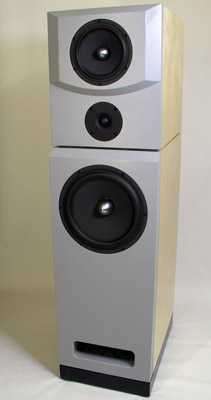
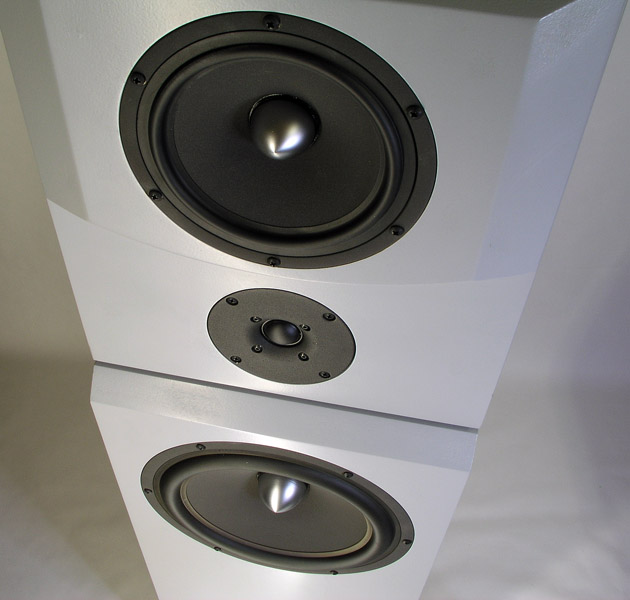
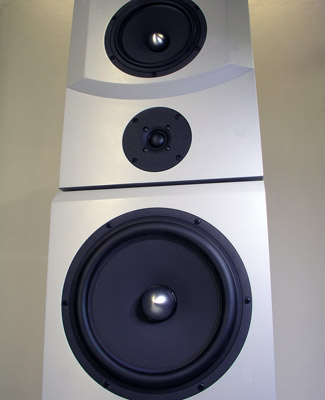
Click image to view large.
FAQs having the answer NO:
Can I make the cabs with a plane front panel? Can I use any other than
the specified drivers? Can I change the cab dimensions without
impairing performance? Do you have more detailed drawings? Do you have
a suggestion for an active version? Can I tilt the cabs*? Do you know
how the vented version sounds compared to TL? Will Jenzen NEXT replace
your DTQWTs? Will there be a version with magnesium drivers?
FAQs having the answer YES:
Can I use 22 or 25 mm MDF?
(Keep
outer dimensions, front panel layout and 19 mm for the mid's outer
panel). Can I use a single
rectangular vent for the midrange transmission line, like 20 x 150 mm
in replacement of the 4 x 30 mm holes? Can I use the T29CF001? Can I
use the CA26RFX bass without changing crossover**?
*:
You may actually tilt the upper cabinet a bit forward (1-3o)
in case your couch is low - or you're not particularly tall...
**: These drivers have maybe 1 dB
difference in sensitivity and having tried the CA26 with the NEXT
crossover and bass LCR circuit in place, I found it to perform
excellent.
Useful links (Please read before writing!):
http://www.troelsgravesen.dk/tips.htm
http://www.troelsgravesen.dk/crossovers.htm
http://www.troelsgravesen.dk/LCR-RC.htm
FAQ (Please read before writing!):
You cannot change cabinet front panel dimensions and drivers' placement
without needing a new crossover - and I cannot help.
You cannot use any other drivers with the crossover shown here.
Please read these files before e-maling:
http://www.troelsgravesen.dk/crossovers.htm
http://www.troelsgravesen.dk/choices.htm

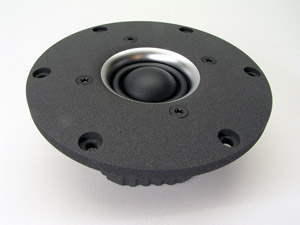
T25C003 and T29CF002
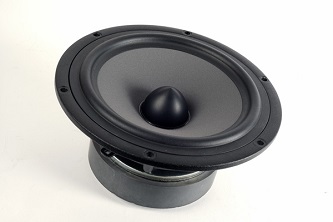
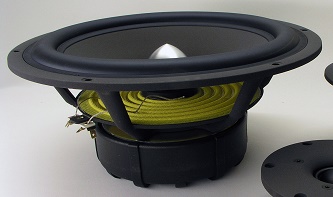
W18NX003 and W26FX002
Jenzen NEXT
T25 Crossover
Back to top
Back to top

Jenzen NEXT crossover follows a
close-to-perfect LR2 topology.
The Jenzen NEXT (T25
version) can be
realised from the Jenzen SEAS ER crossover without trouble. However,
tweeter section here has been given the full treat to reduce a little
too much energy in the 6-8 kHz range, to lift level from 10-20 kHz and
to further smooth roll-off towards lower frequences. Overall tweeter
level is about 1 dB down compared to midrange, providing proper overtone
balance with lots of detail. To make a ruler flat response, reduce R1011
to 1.0 ohm. This is too much treble to my taste.
Compared to the SEAS ER the point of crossover between bass and mid has
been increased some 30-40 Hz to make a perfect integration of bass and
mid with regard to frequency response and phase tracking.
The low point of crossover for bass combined with an increasing
impedance towards lower frequences makes a bump in the 80-120 Hz region,
hence the bass LCR circuit consisting of R3031/L3031/C3021. You can
experiment leaving out this circuit depending on room position. If
placed close to corners I suggest leaving in the LCR circuit. I left it
in despite good distance to nearby walls. Subjectively a slightly deeper
bass is achieved from the LCR circuit.
For mid attenuation I use 2 x 4.7 ohm 10 watt Superes resistors in
parallel and for tweeter attenuation also a Superes resistor, here 2.7 ohm.
For tweeter attenuation 2R2 and 3R3 are included in the kit.
As can be seen from below, I tried spending money where it counts the
most, thus no wax coils this time. The 1.6 mm baked wire coil for the
midrange is possibly as good as it gets. If you want to use wax coils,
look at L2041, L1031, L1041 and L1051, use 16 AWG coils for all. I also strongly
suggest the C-coil for the bass, although not exactly cheap.
Jenzen
Transmission Line Cabinet
Back to top
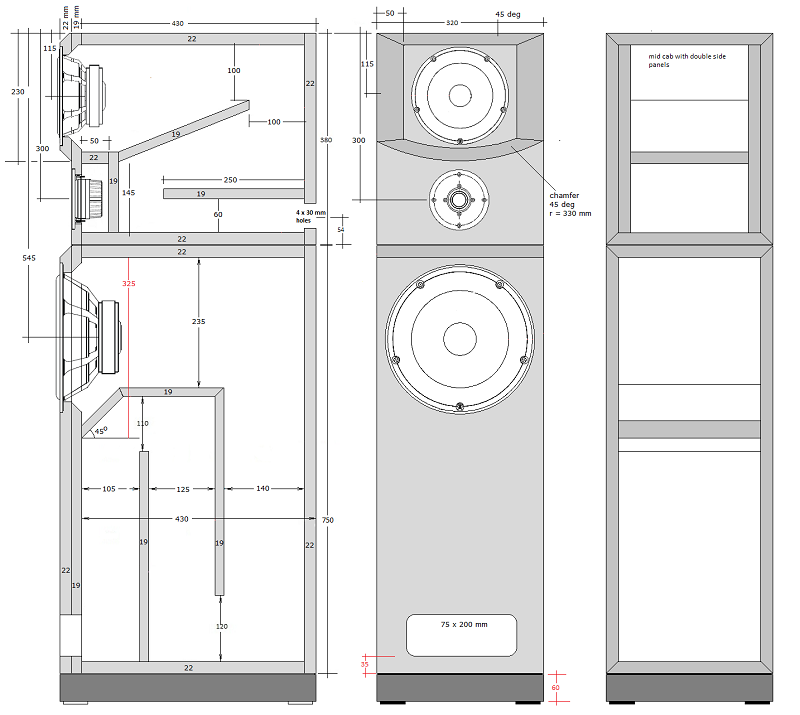
Go
to Jenzen cabinet construction page.
Routings for T25 and
T29 are the same.
Jenzen Bass Reflex Cabinet
In case you may want to make a vented version,
click image below.
If you remove the bass cab transmission line panels you have a net
volume of 78 litres. This makes a nice F3 of 35 Hz. Port tuning = 32 Hz.
Port = 100 mm (ID) x 155 mm length. If you cut depth to 360 mm (depth without front panel) you get 65 litres and
F3 = 38 Hz. Maintain port tuning of 32 Hz and port is now 100 x 197
mm.
With this new cabinet depth for the mid/tweeter - and by removing internal panels - we
have around 25 litres minus volume of tweeter cab and bracings. This fits the
W18NX001 well and I suggest adding a port to the rear of 50 mm (ID) x 75
mm. Stuff the port lightly with damping material to make an aperiodic
tuning. The port leaves you the options of vented, aperiodic and closed
box (the latter by stuffing the port hard). They don't sound exactly
the same and it provides a lot of options for little cost.
Add two
braces to the bass cabinet and one brace to the mid cab. Please check
other files for how this can be made, e.g QUATTRO cabs.
Regardless of your choice, maintain
front panel dimensions, driver layout and front panel chamfering. This is of vital
importance of how the crossover performs. The middriver front panel
provides an unusual flat response from the drivers tested so far.
Jantzen Audio ports: For
bass cab: 2 pcs 100 mm (ID) x 200 mm, item #900029. For mid cab: 2 pcs
50 mm (ID) x 145 mm, item #900023. Cut to required length for mid and
for bass if you choose the large vented option.
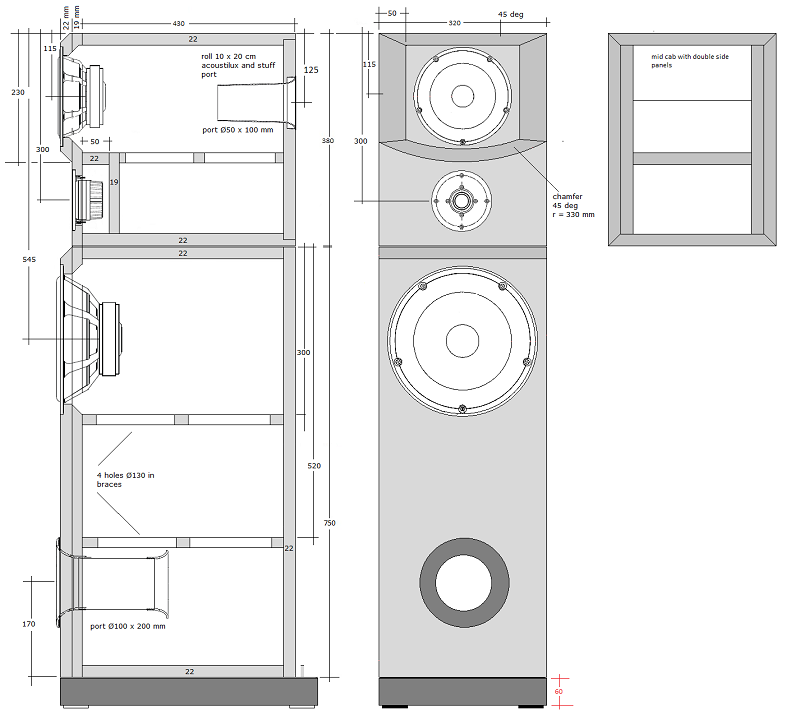
Click image to view large.
Measurements
T25
Back to top
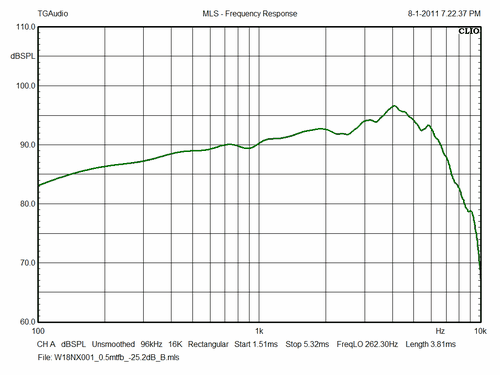
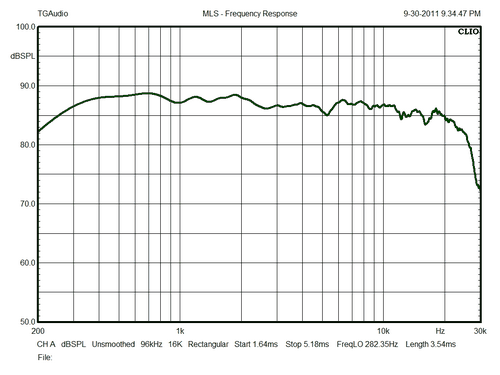
Left: Once again, the W18NX001 frequency
response without crossover attached. Smoooth and easy!
Right: Final SPL from mid and tweeter driven from crossover.
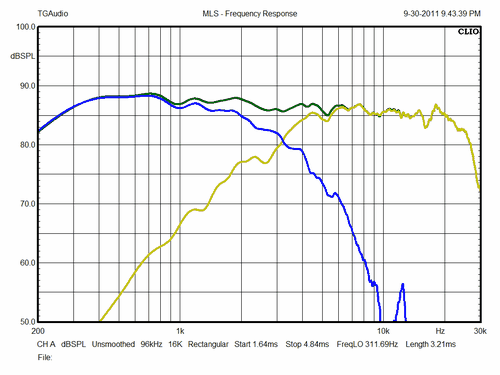
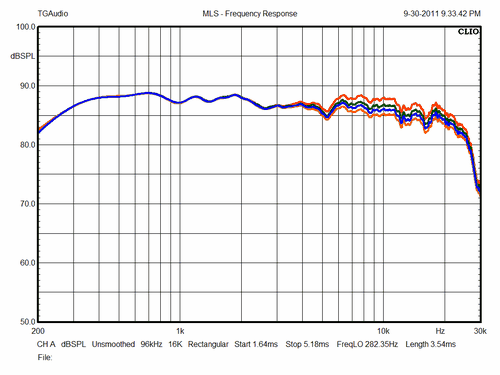
Left: Point of crossover between mid and tweeter is around 2800 Hz
despite minor dip in tweeter roll-off around 2.5 kHz.
Right: Tweeter attenuation from R1011 = 1.5 ohm, 2.2 ohm, 2.7 ohm and 3.3
ohm. My preferred level is 2R2. Adjust to personal taste. 3.3 ohm is
not included in kit.
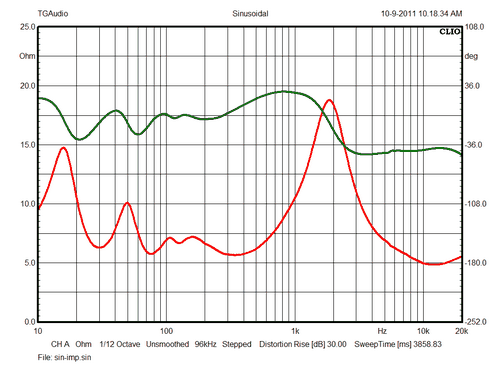 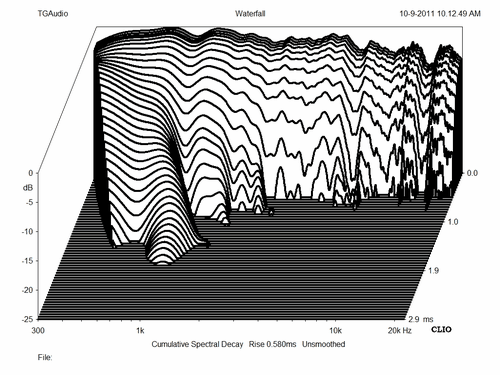
Left: Final system impedance. Note modest phase angles below 100 Hz, an easy load on
amplifiers. Right:
CSD 25 dB scaling.
The
Complete NEXT T25 Kit
Back to top
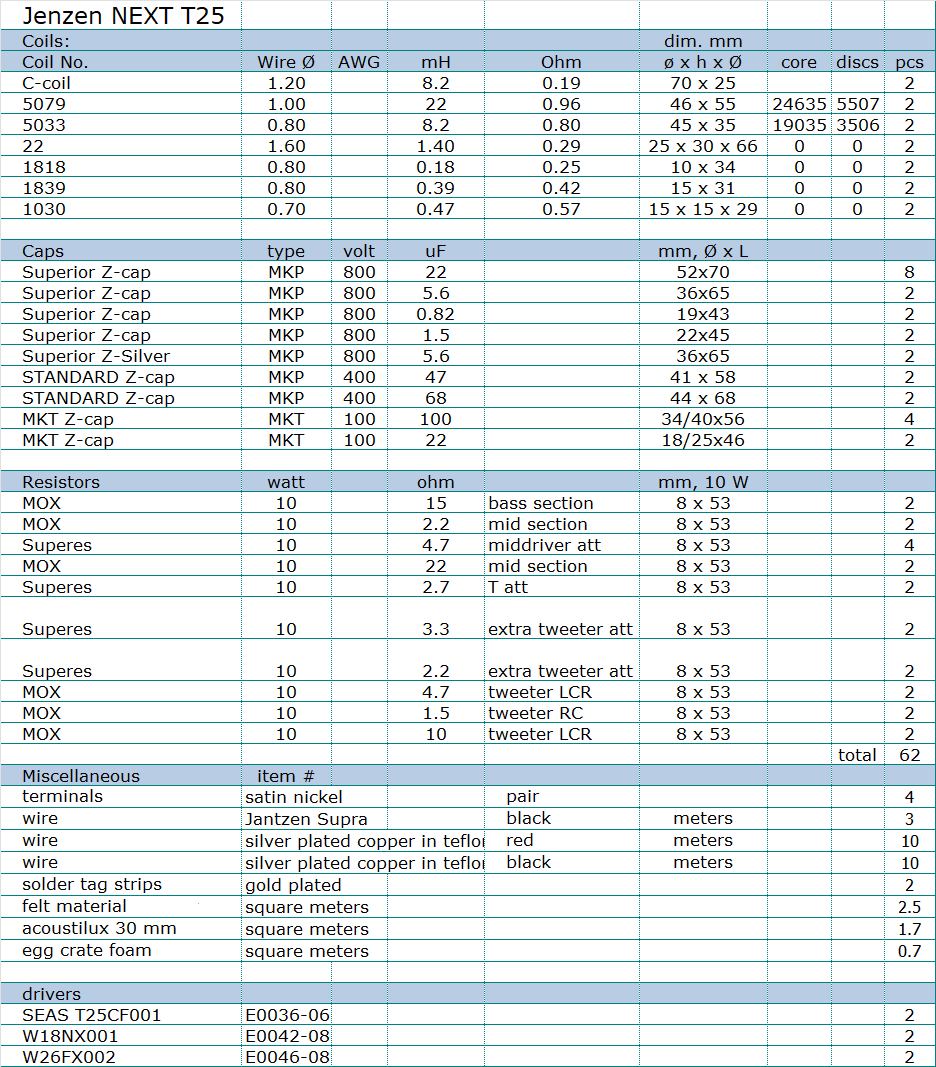
For price quotation
incl. shipping, please contact Jantzen Audio at: contact@jantzen-audio.com
DOWNLOAD KIT SALES
PRESENTATIONS HERE 
|
I strongly suggest including the damping materials in your purchase as this
is of vital importance in making the bass TL work properly.
Included are 4 pairs of
terminals. If you plan for not bi-wiring, ask Jantzen to
include two pairs only.
For vented cabs:
Jantzen Audio ports: For
bass cab: 2 pcs 100 mm (ID) x 200 mm, item #900029. For mid cab: 2 pcs
50 mm (ID) x 145 mm, item #900023. Cut to required length for mid and
for bass if you choose the large vented option.
|
All technical
questions at:
troels.gravesen@hotmail.com
T25
Crossover Layout
Back to top
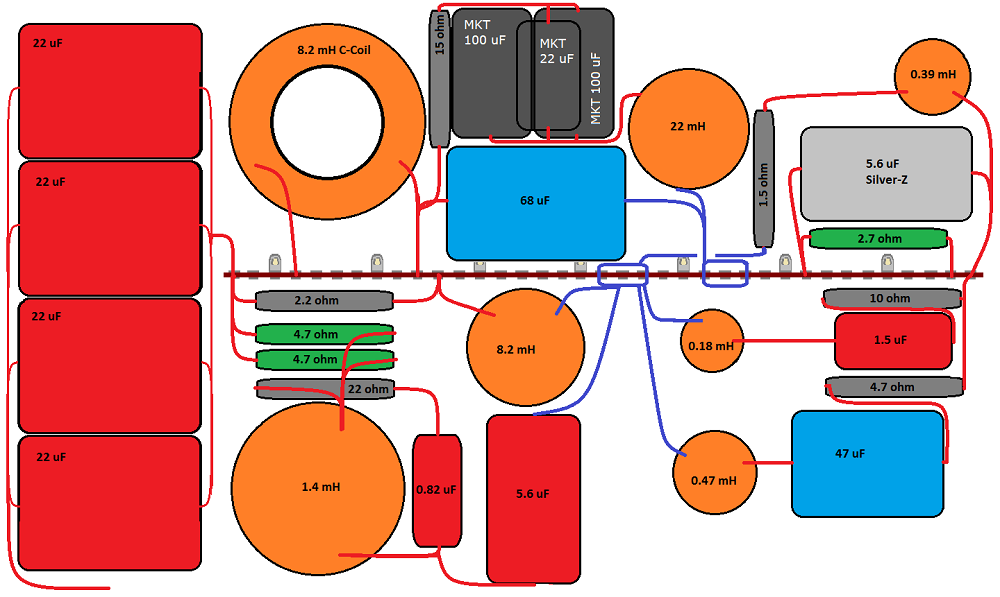
Click image to view large.
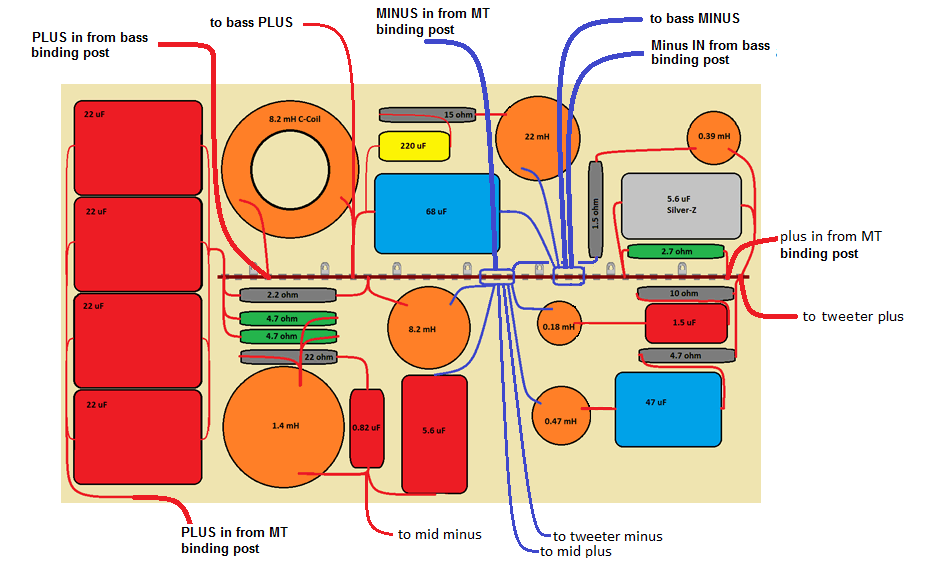
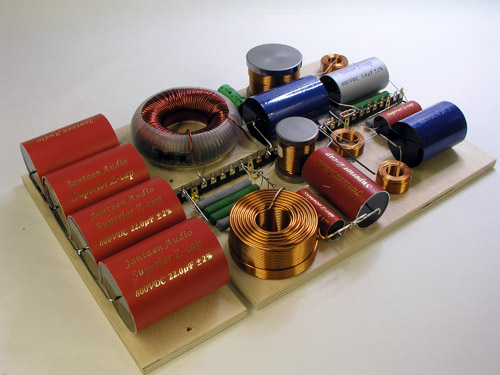
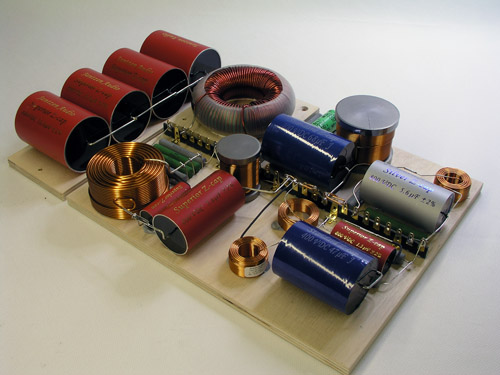
Click images to view large
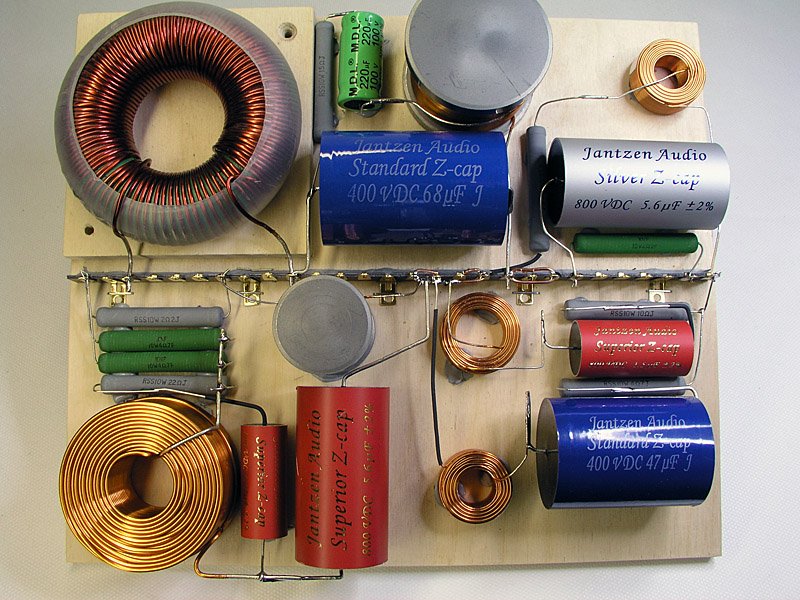
Click image to view large (2000 pixel
width)
Pay notice the 220 uF electrolytic has been replaced by MKT
caps, 100+100+22 uF in parallel.
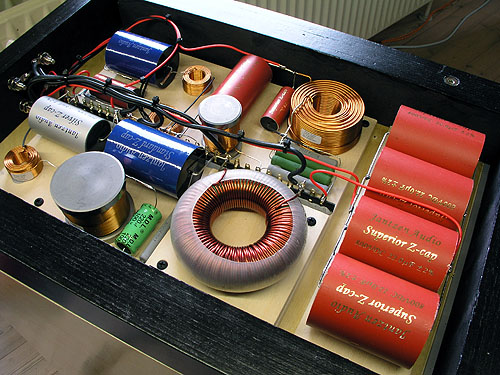
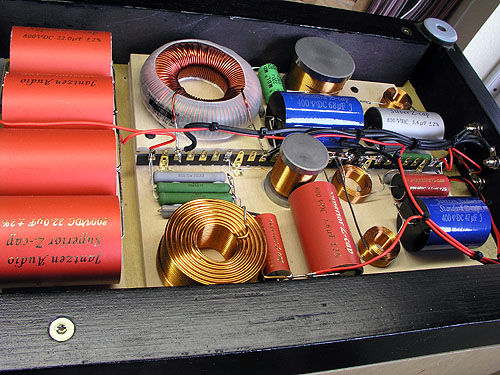
Implementation of crossover in speaker
base. Click images to view large.
The Crescendo Dome
T29CF002
Back to top
One of my intentions
with this construction was to prove the T25 as good as the
Crescendo but I had to bite the bullet and admit the Crescendo does a
bit better. Not a lot, but noticeable. Tweeters' response on the Jenzen
baffle are not the same from the two tweeter, thus requires different crossovers, although
they use the same basic topology. So, is this a result of
different crossovers or actually overall quality of domes? I can't tell what it is but only say that I have had a bit of a crush on
the Crescendo set-up. Maybe the
wide surround of the Crescendo proves its thing from the shallow sloped
crossover.
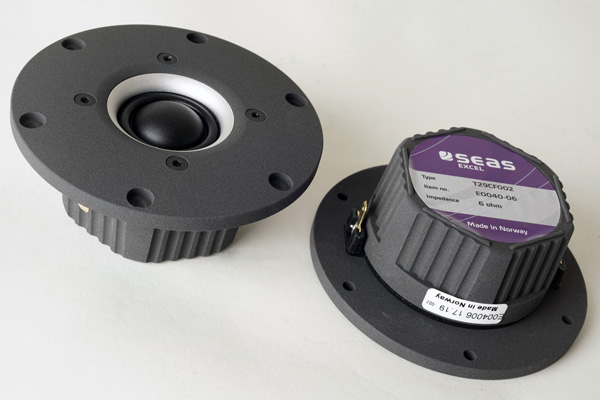
T29CF002 Crescendo tweeter
Crescendo Crossover

Only differences compared to T25C003
tweeter are tweeter attenuation resistor R1011 and LCR circuit, R1051+L1051+C1051.
Crescendo Kit
Back to top
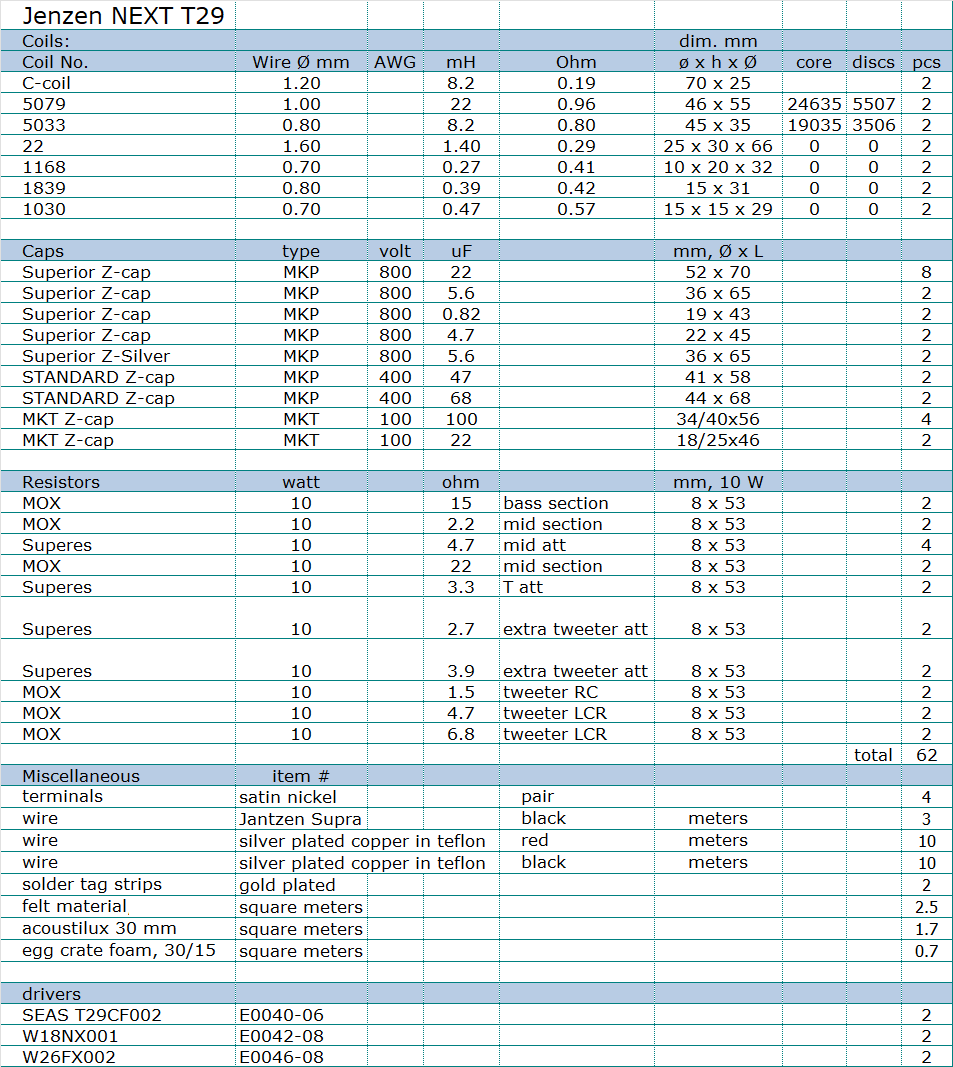
For price quotation
incl. shipping, please contact Jantzen Audio at: contact@jantzen-audio.com
DOWNLOAD KIT SALE
PRESENTATION HERE:

I strongly suggest including the damping materials in your purchase as this
is of vital importance in making the bass TL work properly.
4 pairs of
terminals are included for bi-wiring or bi-amping.
For ported cabs:
Jantzen Audio ports: For
bass cab: 2 pcs 100 mm (ID) x 200 mm, item #900029. For mid cab: 2 pcs
50 mm (ID) x 145 mm, item #900023. Cut to required length for mid and
for bass if you choose the large vented option.
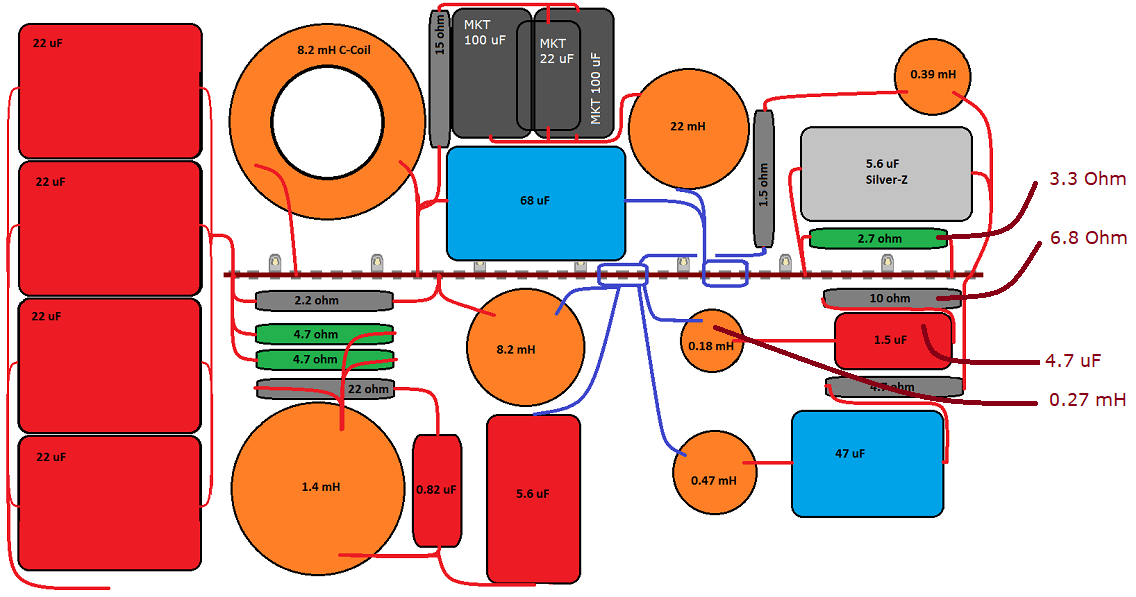
Crossover changes for T29 tweeter.
T29 measurements
Back to top
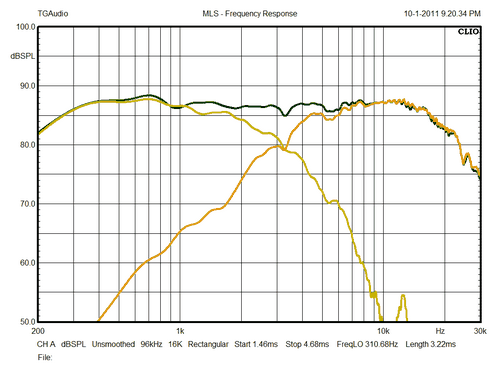
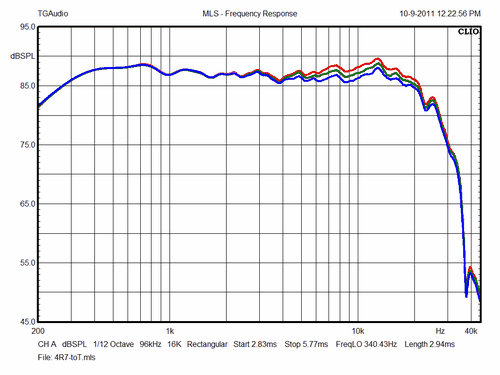
Left: Point of crossover ~3 kHz.
Right: Tweeter response from R1011 = 3R3 (red), 3R9 (green) and 4R7
(blue). My preferred setting is with 4R7 to tweeter.
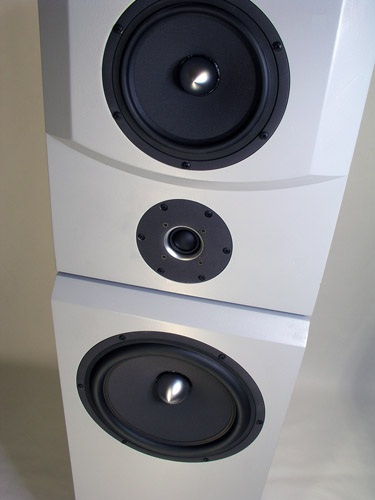
Click image to view large.
Back to top
|


































